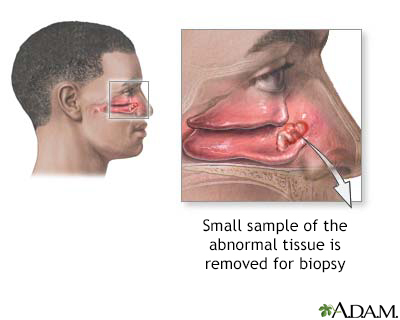Nasal mucosal biopsy
Definition
A nasal mucosal biopsy is the removal of a small piece of tissue from the lining of the nose so that it can be checked for disease.
Alternative Names
Biopsy - nasal mucosa; Nose biopsy
How the Test is Performed
A painkiller is sprayed into the nose. In some cases, a numbing shot may be used. A small piece of the tissue that appears abnormal is removed and checked for problems in the laboratory.
How to Prepare for the Test
No special preparation is needed. You may be asked to fast for a few hours before the biopsy.
How the Test will Feel
You may feel pressure or tugging when the tissue is removed. After the numbness wears off, the area may be sore for a few days.
A small to moderate amount of bleeding after the procedure is common. If there is bleeding, the blood vessels may be sealed with an electric current, laser, or chemical.
Why the Test is Performed
Nasal mucosal biopsy is most often done when abnormal tissue is seen during examination of the nose. It may also be done when the health care provider suspects you have a problem affecting the mucosal tissue of the nose or for diagnosis of certain diseases like primary ciliary dyskinesia or granulomatosis with polyangiitis.
Normal Results
The tissue in the nose is normal.
Normal value ranges may vary slightly among different laboratories. Some labs use different measurements or test different samples. Talk to your provider about the meaning of your specific test results.
What Abnormal Results Mean
Abnormal results may indicate:
- Cancer
- Infections, such as tuberculosis
- Necrotizing granuloma, a type of tumor
- Nasal polyps
- Nasal tumors
- Sarcoidosis
- Granulomatosis with polyangiitis
- Primary ciliary dyskinesia
Risks
Risks involved with this procedure include:
- Bleeding from the biopsy site
- Infection
Considerations
Avoid blowing your nose after the biopsy. Do not pick your nose or put your fingers over the area. Gently squeeze the nostrils shut if there is bleeding, holding the pressure for 10 minutes. If the bleeding doesn't stop after 30 minutes, you may need to see your doctor. The blood vessels may be sealed with an electric current or packing.
Gallery



References
Batra PS, Wrobel BB, Trimarchi M. Systemic diseases of the nose and sinuses. In: Flint PW, Francis HW, Haughey BH, et al, eds. Cummings Otolaryngology: Head and Neck Surgery. 7th ed. Philadelphia, PA: Elsevier; 2021:chap 51.
Bauman JE. Head and neck cancer. In: Goldman L, Schafer AI, eds. Goldman-Cecil Medicine. 26th ed. Philadelphia, PA: Elsevier; 2020:chap 181.
Judson MA, Koth LL, Baughman RP. Sarcoidosis. In: Broaddus VC, Ernst JD, King TE, et al, eds. Murray and Nadel's Textbook of Respiratory Medicine. 7th ed. Philadelphia, PA: Elsevier; 2022:chap 93.
